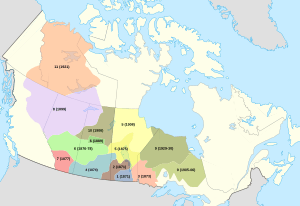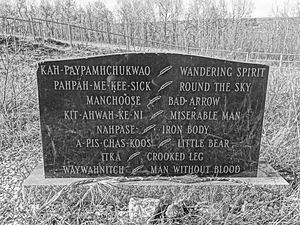Wandering Spirit (Cree leader) facts for kids

Wandering Spirit (also known as Kapapamahchakwew or Esprit Errant) was a Cree war chief. He was born around 1845 and died in 1885. He led a group of Plains Cree people. Not much is known about his early life. Most information starts just before the 1885 Frog Lake Massacre. It ends with his trial and execution.
Wandering Spirit was a young war chief. He often disagreed with the main leader, Chief Big Bear. When Big Bear was away, Wandering Spirit and Big Bear's son, Imasees, were in charge. In 1885, both tried to become the main leader but did not succeed. Wandering Spirit's attempt to lead failed. People valued Big Bear's experience more. Wandering Spirit wanted to challenge those who were unfair to them. Besides the Frog Lake Massacre, Wandering Spirit was known for his success in battles. He fought against Blackfoot warriors many times and won.
Contents
The Frog Lake Massacre: A Difficult Time
Why the Frog Lake Event Happened
The Frog Lake Massacre happened during a tough time. There was not enough food. The environment was changing. There were also disagreements between different groups. In the 1880s, the Plains Cree faced starvation. This was because the buffalo population was shrinking. The Cree traditionally relied on buffalo for food. Overhunting made buffalo scarce across Canada.
This caused tension between the Plains Cree and the Métis. The Métis were seen as taking over Cree hunting lands. Another reason for the buffalo decline was the use of firearms. European settlers also wanted buffalo furs and pemmican. These things led to too much hunting. The Plains Cree often went onto Blackfoot lands to find buffalo. They blamed the Hudson's Bay Company (HBC) for their troubles. They felt the HBC's trading actions forced them to trespass.
Without buffalo, Indigenous groups started to rely on government food supplies. These supplies were given out by local Indian agents. This was a big problem. Sometimes, the food was not enough or was spoiled. Indigenous groups felt the government was not keeping its promises from treaties. Meanwhile, political parties in Canada were trying to save money. They cut funding for programs in the west. Hunger and politics made relationships worse. This was true between Indigenous people and European traders.
After many fights with the Blackfoot, the Canadian government told the Plains Cree to move. They were sent to Frog Lake, Alberta. There, they shared land with their relatives, the Woods Cree. Frog Lake was not a reserve. Big Bear's group lived there with very little help or food from the government.
Indian agents tried to make them move to a reserve. They did this by refusing to give them food. The local Indian agent was Thomas Quinn. Historians say he was "mean-spirited" and "lacked compassion." Once, he called Indigenous people to the food house. He promised them food. Then he said it was an April Fool's prank. They would get nothing. Quinn was not liked by the Plains Cree. Wandering Spirit especially disliked him. After one argument, Wandering Spirit had threatened Quinn. The government then suggested Quinn move to Fort Pitt Provincial Park for safety. Quinn refused and stayed at Frog Lake.
This unhappiness played a big part in the massacre. Big Bear wanted to find peaceful solutions. But Wandering Spirit wanted to fight back more aggressively. This idea appealed to the warriors in the group. It made him popular. This led to the deaths of nine European traders.
The Frog Lake Attack
Big Bear was against the attacks. But he was later put in jail for not stopping them. Wandering Spirit was the war chief. He had the most power in the group during the attack. He led the men into the Frog Lake settlement. Big Bear was not there at the time.
The Métis had just won the Battle of Duck Lake. This made the Cree feel stronger. They believed they could fight the Canadian government. They decided to act against the government themselves.
They hoped to take people in Frog Lake as hostages. They wanted to take the supplies there. Then they planned to join the Métis and Louis Riel at Fort Pitt. When the attack on Frog Lake began, they took Thomas Quinn hostage. They chose him because of his position and his past actions. The Cree men let the townspeople go to church. But then they would not let them leave. They held them hostage inside. The Cree tried to move their hostages to their war camp. Quinn refused to cooperate. Wandering Spirit then shot him. This caused panic among the hostages. Wandering Spirit's actions led his warriors to kill eight more unarmed people. With nine hostages dead, the Cree took the remaining settlers as prisoners.
The Cree took their prisoners to the war camp. This camp was set up outside the settlement before the battle. The prisoners were told they would be safe inside the camp. But anyone found outside would be seen as an enemy.
Big Bear was eating breakfast when he heard the news. He immediately returned to his group. He wanted to stop the violence. He moved the group further north. He hoped to keep them away from more fighting.
Taking Over Fort Pitt
Wandering Spirit decided to capture Fort Pitt. This was two weeks after the Frog Lake Massacre. The fort had food and ammunition. The starving Cree wanted these supplies. Louis Riel also supported taking the fort. Fort Pitt had a North-West Mounted Police (NWMP) group. This group could be a threat during a rebellion.
The fight was short and almost no one was hurt. Corporal David Cowan was shot and killed. After that, Fort Pitt was given up to the Cree.
The death of an NWMP officer caused a big stir. Settlers worried about another rebellion led by Riel. Newspapers like the Saskatchewan Herald showed the Cree as villains. But Wandering Spirit said the Cree were only reacting to starvation. He said there was no bigger plan. During this time, Wandering Spirit's group followed him because of the crisis. But they generally hated the violence.
The group moved north with their stolen supplies. Law enforcement chased them. After several months, Wandering Spirit was cornered. He gave up and was taken into custody.
Trial and Final Days
After Wandering Spirit was captured, he was held until his trial. The trial took place at Battleford. Magistrate Charles Rouleau oversaw the trial. Rouleau sentenced Wandering Spirit to be hanged. Rouleau called Wandering Spirit "the greatest killer ever to walk on two legs in America." The government used the death penalty in Wandering Spirit's trial. This was seen as a way to show its power. It wanted to control the land and its people during a time of unrest.
On November 27, 1885, Wandering Spirit was executed. This was part of the 1885 hangings at Battleford. This event holds the record for Canada's largest mass execution.
Wandering Spirit's body was buried in a mass grave in Battleford. At first, the grave had no marker. In December 1985, a tombstone was put up. It had the names of the eight men buried there. This marked the 100th anniversary. The North West Centennial Advisory Committee and Battleford City Council paid for it. They also got a grant from the Provincial Department of Culture and Recreation.
Wandering Spirit's Legacy
In 1976, Pauline Shirt and Vern Harper started the Wandering Spirit Survival School in Toronto. The school first met in their living room. It had only a few children. Soon, it needed more space. They moved temporarily to the Native Canadian Centre. Then they found a suitable place. It became an alternative school. The school was named after Wandering Spirit. He was Pauline Shirt's great-grandfather. In 1983, the school was renamed First Nations School of Toronto. A documentary about the school was made in 1978. You can find it in the National Film Board of Canada archives. In February 2019, the school was renamed Kapapamahchakwew–Wandering Spirit School. His great-great-granddaughter was the main female dancer at the renaming ceremony.
In 1985, a tombstone was placed at Battleford. It listed the names of the eight men executed there. The North West Centennial Advisory Committee (NWCAC) and Battleford City Council put it up. This marked 100 years since the executions. Culture and Recreation Minister Rick Folk attended. So did Chief Lawrence of Poundmaker, NWCAC member Gordon Tootoosis, and Harvey Johnson. Harvey Johnson was the Director of the NWCAC. Irwin McInstosh, Chairman of the NWCAC, said: "This mass grave commemoration is the last historical date of any significance in the North West Rebellion." Rick Folk added: "We are not here to pass judgement on the Indian people who lie buried here in this mass grave, that was done 100 years earlier when they were arraigned for acts of violence during the Rebellion but, this gravesite marker will serve as a call to peace and a reminder that violence and war is never the solution." A sign and a permanent teepee were also added that year.
In 2013, the gravesite was damaged. Ray Fox, the groundskeeper, spoke about the damage. He said: "I'm just saying we need to talk about these kinds of things because this is not pretty, as you can see, when you're looking at this gravestone and it's been deliberately pushed over and our teepee structure here that we erected as a memorial to these warriors is strung all over this place in this piece of property. That's not respect." He added that no matter what someone thinks of the men's actions, their final resting place should be respected.


